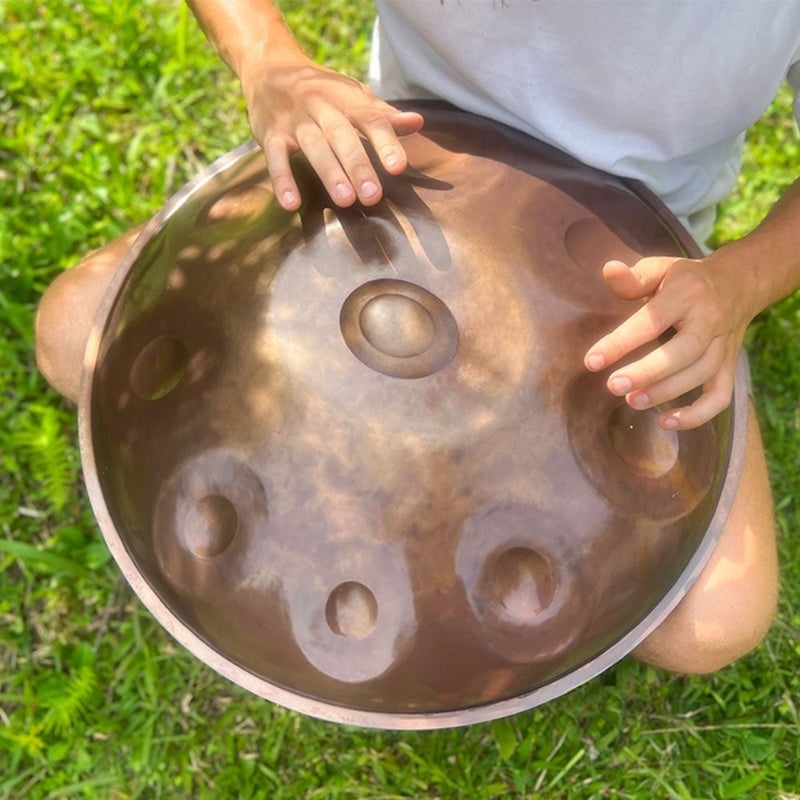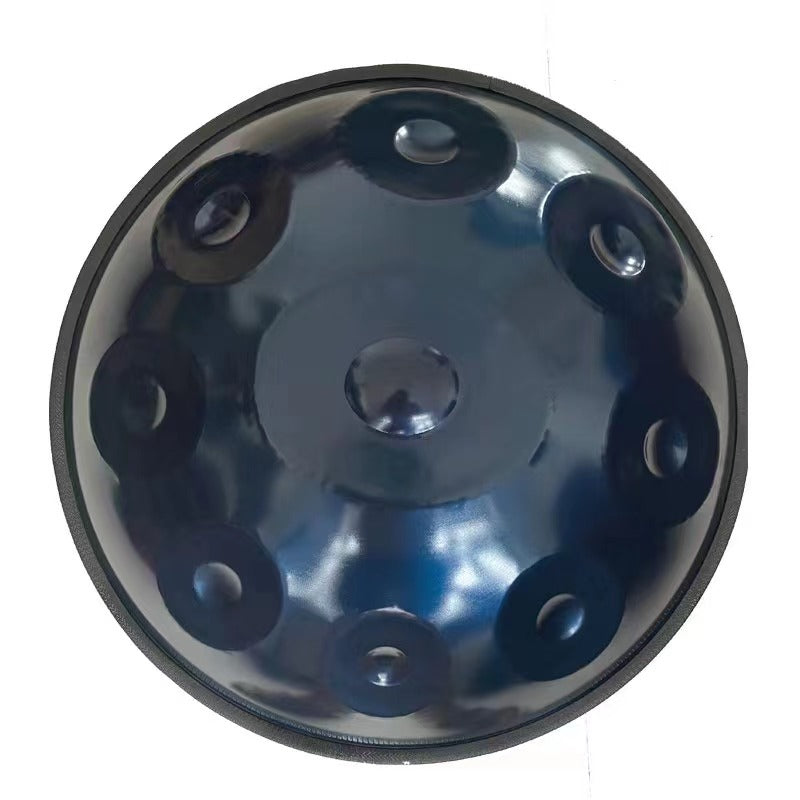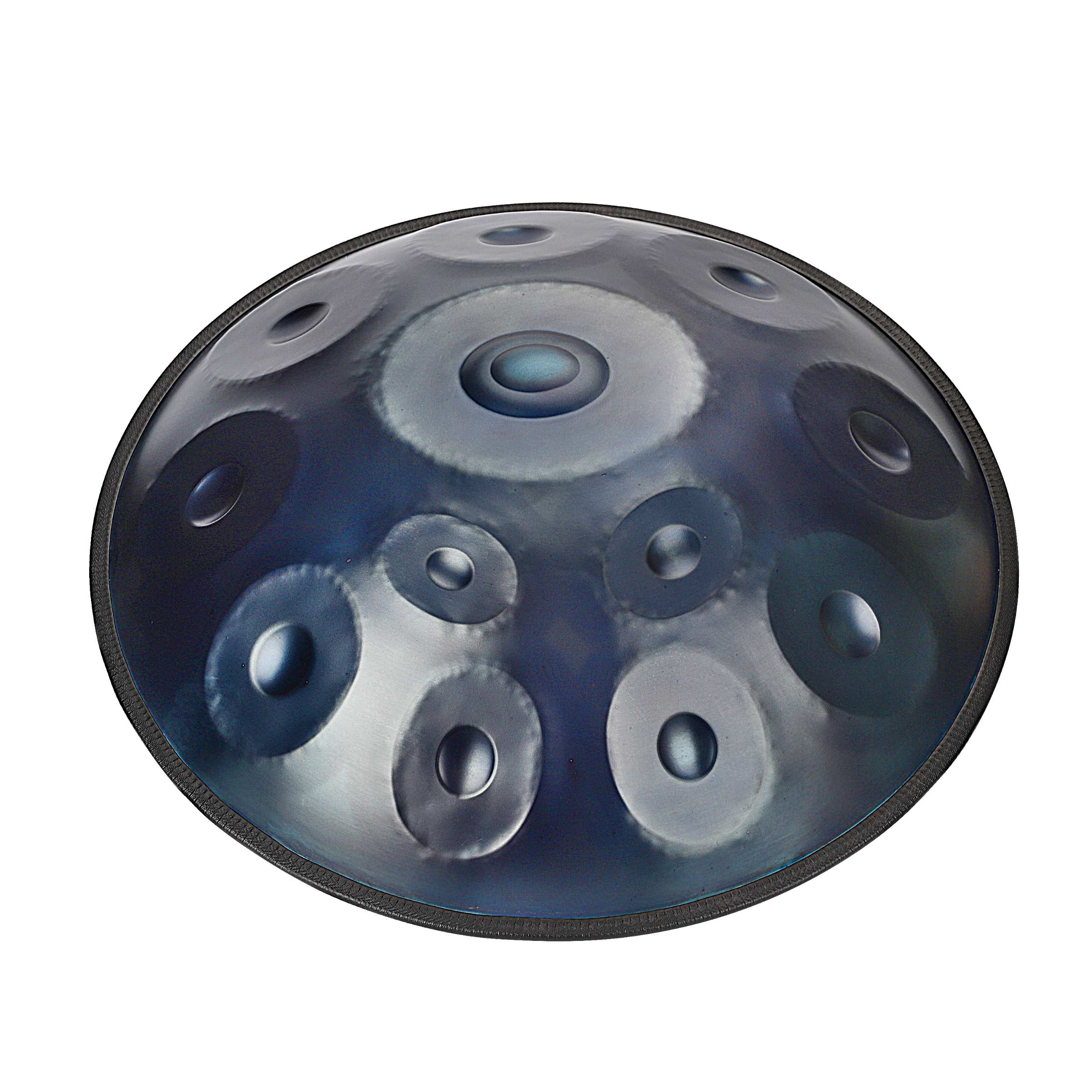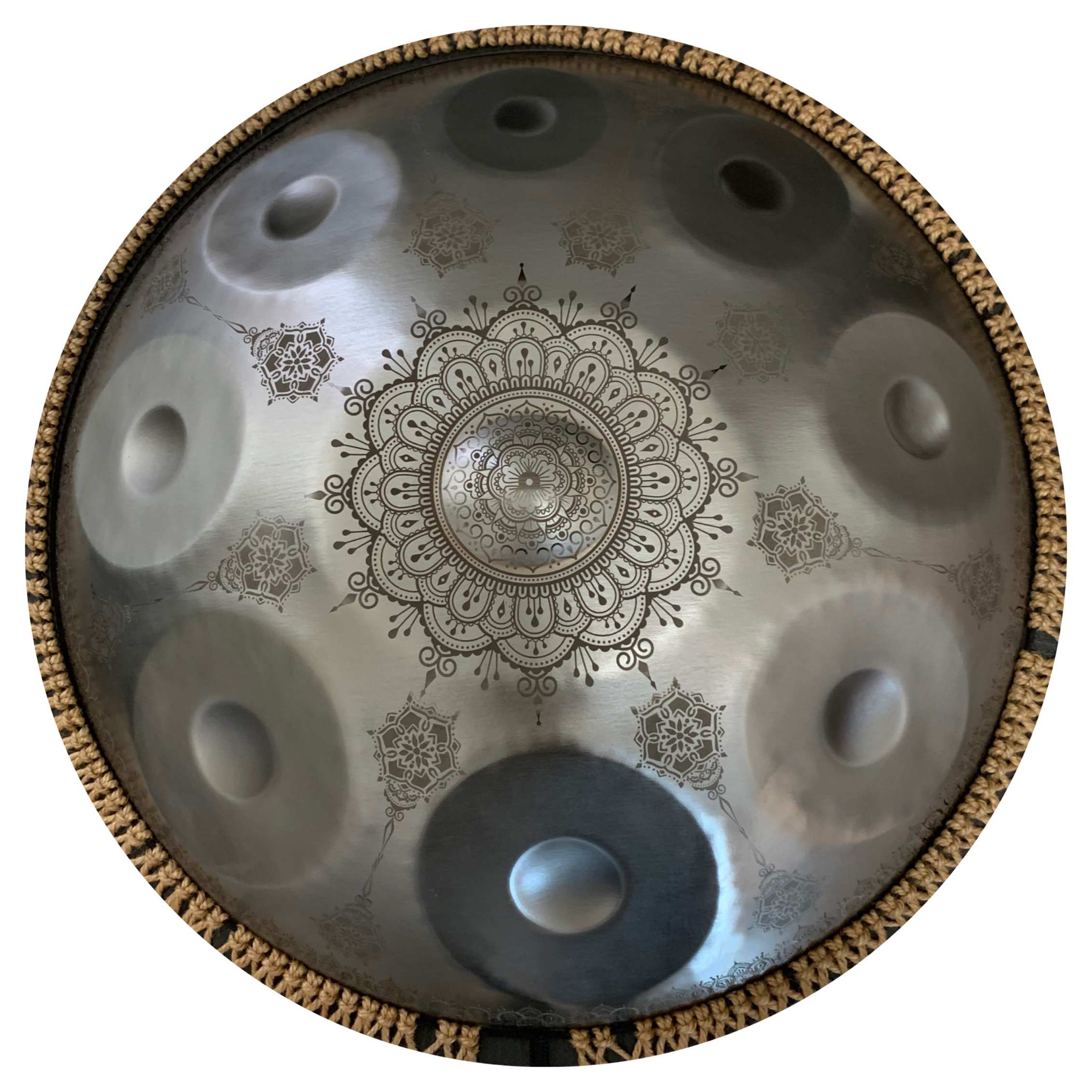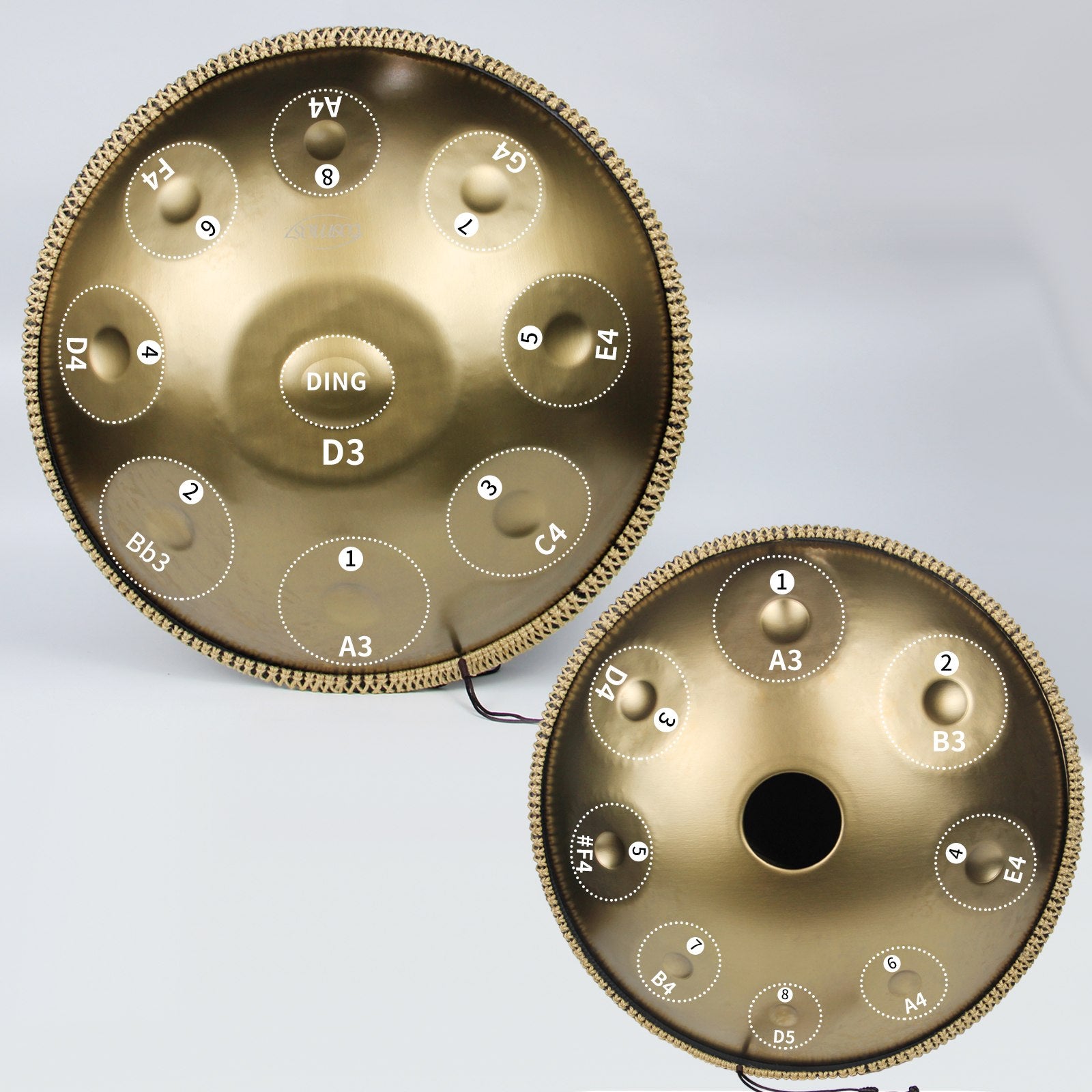Before proceeding to compare a steel tongue drum and a handpan, recognizing the features, advantages, and distinctions of each instrument is crucial. The two instruments are completely different in their sound. At the same time, they create totally different moods and experiences while playing them. Here is a specification comparison that will assist you in making the right choice of an instrument that meets your needs.

Construction and Sound Production
Handpans consist of successfully joined two metal hemispheres that are bonded with a special glue. The top surface of the Chinese bell is designed with several tone fields which are located around a central dome that is known as ding; these particular areas are hammered into particular pitches. If these fields are struck, they vibrate and give out a bright, deep sound that can ring on for a while. The process is intense and very precise as the metal has to be hammer-shaped to around 2000 hammer strikes to be tuned correctly.
Tank drums, or steel tongue drums, are cast from a piece of metal and contain a set of “tongues” slit into the base metal, and these tongues make vibrations when they are stricken. The design also enables easy tuning, commonly with magnets for tuning, and this leads to the production of the bell-like and meditating music pattern.
Size and Portability
Handpans are more oversized and comparatively heavy where the weight is said to range between 7-10 pounds and size between 20 inches in diameter. This makes them more delicate to transport and to store. Steel tongue drums are smaller and measure from 5. Having diameters ranging from 5 to 12 inches and weighing between 2 and 10 pounds, Coolpercussion products are portable and relatively easy to maneuver.
Playability and Techniques
Handpans are intended to be played with hands so you can control the dynamics of sound. To produce different tones and rhythms, players move their fingers, thumbs, and palms. Therefore, singers have much to express. The big note heads allow for plenty of speed and moderate complexity of music without hitting neighboring notes accidentally.
Regarding the way of performing steel tongue drums, you can use hands or mallets. Swinging mallets can allow beginner music operators to get cleaner, often repeated noises. It is easier for new performers to target the desired notes, thus helping with instruments that require percussion.
Extraordinary Option Of Magnets For Re-tuning Renders Them Suitable For Several Types Of Music
Sound and Volume
Handpans are characterized by having warm tones when played and giving out a percussive sound when played, followed by a long harmonic ring. They are louder and, therefore, perfect for single performers as well as for groups and orchestras. Steel tongue drums, though lower in pitch, provide a bells-like, reflective sound that resonates well for contemplative, quiet performers and players and spaces and environments with less crowd.
Cost and Maintenance
Handpans are more costly than hang drums because more time and effort are needed to develop the pan and tune it to another. Most states cost between $1,000 and $4,000 and more, depending on the maker of the state and the number of notes to be included. Because of this, it is imperative to tune them frequently with the help of professionals for them to produce high sounding sounds.
A steel tongue drum is relatively cheaper, while the excellent quality one cost between $100 and $500. It is more convenient to maintain and tune them because the tongues can be manipulated using magnets or any simple instrument. Thus, they are suitable for learners, casual users, or those with a limited budget.
Versatility and Use Cases
Musical handpans are desired by players who want an instrument that can be used as a primary as well as secondary instrument, and that is also variable and capable of emitting many different rhythms and harmonies at the same time. It is almost impossible to specify the range of their usage as they are popular with ambient and world music, jazz people, and even classical musicians. They are also used in sound healing and therapy because of their ringing and relaxing sounds.
Through being portable and compact, steel tongue drums have gained popularity mostly in meditation, yoga, and most therapies because of the relaxing sound they offer. They are relatively simple and can be played by virtually anyone, especially those with no prior music training or experience. They can be engaging as the ideal first musical or percussion tool for anyone who is just getting into the aspect of music.
Pros and Cons
Handpan Pros:
- Rich, resonant sound with long sustain.
- Suitable for dynamic, expressive playing.
- Ideal for a wide range of musical genres.
Handpan Cons:
- Expensive and requires regular maintenance.
- Larger and heavier, making it less portable.
Steel Tongue Drum Pros:
- Affordable and easier to maintain.
- Lightweight and portable.
- Flexible tuning options with magnets.
Steel Tongue Drum Cons:
- Quieter with a less resonant sound.
- Limited dynamic range compared to handpans.
Making the Decision: Handpan or Steel Tongue Drum?
Consider your musical goals, budget, and personal preferences:
Budget: Handpans are more costly than steel tongue drums are they provide a good value for producing tonal sound and are relatively simple to maintain.
Portability: Non-steel tongue drums are more portable as compared to steel tongue drums as they do not take up much space when transported and stored.
Musical Goals: Handpans for different styles of music; steel tongue drums for therapeutic and meditating music.
Playing Style: Each note on a handpan is played with fingers and there is great control over them. Steel Tongue Drums can be played by hands as well as mallets.
Maintenance: Handpans demand professional re-tuning regularly, while playing steel tongue drums is relatively simpler when it comes to tuning.
The histories of both handpans and steel tongue drums are as exciting and are connected with the development of steel percussion instruments. Handpans were invented in the early part of the current millennia by Swiss innovators Felix Rohner and Sabina Schärer on the basis of Trinidad and Tobago’s steel pan. Steel tongue drums by Dennis Havlena originate from the African and Asian slit drum as well as the steelpan music and tempo.
Methods of playing/tactics and complex strategies
Handpan Techniques
Slap Tones: With the side of the thumb or of the fingers for staccato, harsh sounds.
Harmonics: Gently tapping certain areas in order to get resonant consonances.
Ghost Notes: Soft when thinking of the undertones.
Flam and Drag: Rapid, successive hits for rhythmic variations.
Steel Tongue Drum Techniques
Mallet Playing: Two pieces of music in the cross going to strike with the tone of different mallets.
Finger Drumming: Tender, fine details with the tips of their fingers.
Hand-Rolling: There is the construction of a flow of continuity of the sound.
Damping: Stopping and restarting vibration for the short burst notes.
Community and Resources
Both instruments have active groups with numerous available sources to use for the players. Newsgroups and other bulletin boards, social networking sites, and specific Websites are available that detail how to purchase such instruments, how to care for them once acquired, and how to play them. Performances also promise a chance to meet other people to play with, to learn new things, and to try out other instruments.
Handpan Communities:
Handpan.org: A community for sharing ideas about handpans, how to play them, and upcoming events.
Facebook Groups: The Handpan specific groups present in the social media platform were identified as “Handpan Musicians United” and “Handpan Swap and Sale. “
Steel Tongue Drum Communities:
Cool Percussion: Includes comparative, review, and people’s opinion options.
Professional Composers: Gives detailed handouts and useful material for the composers.
The choice of whether to go for a handpan or a steel tongue drum depends on certain factors. Each of these instruments provides the audience with rather valuable and versatile types of musical performances. Different instruments are appropriate for different people depending on the difference in people as well as their goals in the musical career they wish to pursue.

